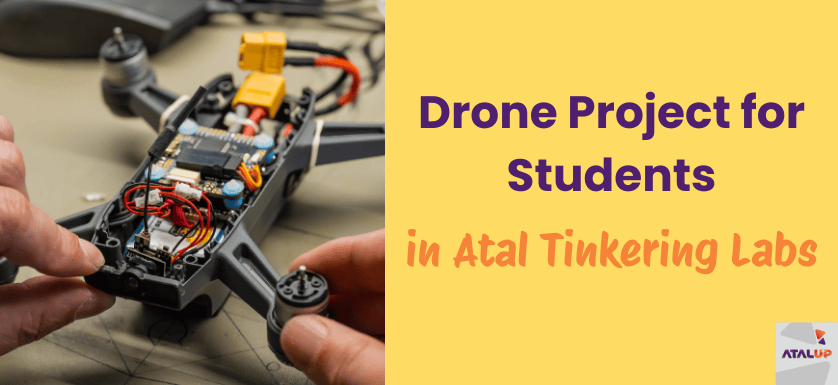
Think drones are just for delivery or capturing aerial views? Not anymore. In India’s Atal Tinkering Labs (ATLs), students are building, coding, and flying their own drones, not just as a hobby, but as part of a structured curriculum that blends science, engineering, and fun.
Welcome to the Drone Module, where 6th to 12th-grade students explore future tech with hands-on projects that teach real-world STEM skills. It’s not theory-heavy, it’s about building, testing, and learning by doing.
Explore Drone Project for Students Under Atal Tinkering Lab
The drone project for students under ATL is not just about assembling toy drones. It’s about understanding aerodynamics, electronics, sensors, and even drone laws in India. With expert-curated content, this module helps students explore:
- What drones really are and their real-life applications.
- Why understanding flight dynamics is essential.
- How to build and program your own drone from scratch.
From regulations to coding to soldering parts, it’s a complete journey. And the best part? Students actually build a working drone by the end.
Syllabus of Drone Project for Students
Here’s a deeper look at the 9 chapters included in the drone project for students under ATL. Each one builds practical knowledge step-by-step, preparing students not just to fly a drone, but to create one.
Chapter 1: Key Features of Drone Regulations 1.0
Before touching any hardware, students learn the rules. This chapter explains India’s RPAS (Remotely Piloted Aircraft System) regulations. Students explore operational permissions, the concept of “No Drone Zones,” how drones are registered through digital platforms, and what happens in case of violations. It helps them become responsible drone pilots with an understanding of legal compliance.
Chapter 2: Introduction to Drones and Their Applications
Here, students discover what drones are, their origin story, and how different countries (including India) are investing in drone tech. The module also relates drone usage to tinkering labs, highlighting real-life applications like agriculture, rescue operations, and logistics. Students also learn dos and don’ts, ensuring they work with safety and awareness.
Chapter 3: Dynamics of an Aerial System
This chapter teaches the physics of flight. Students understand the four forces, lift, weight, thrust, and drag, and how they affect drone movement. They also explore three principal axes: longitudinal (roll), lateral (pitch), and perpendicular (yaw), which control how a drone tilts, turns, and balances mid-air.
Chapter 4: Stability and Control
Flying a drone isn’t enough, controlling it precisely is key. Students learn what makes a system stable or unstable and how drones maintain equilibrium in different environments. They understand the importance of roll, pitch, yaw, and throttle in controlling speed and direction. These concepts form the base for smooth navigation and drone handling.
Chapter 5: Drone Sensors
Drones use multiple sensors to sense height, motion, and orientation. Students explore essential sensors like the accelerometer, barometer, gyro sensor, and magnetometer. They also learn about advanced ones like sonar, thermal sensors, and chemical sensors, which make drones smarter and more responsive to the environment.
Chapter 6: Propulsion and Vertical Motion
This chapter breaks down how drones lift off and stay in the air. Students study the role of propellers, motors, and propulsion systems. They compare materials, shapes, and structures to see how they affect speed and energy efficiency. This hands-on knowledge is crucial while choosing or designing drone components.
Chapter 7: Battery of a Drone
Power management is critical. Students learn the difference between wet and dry cell batteries, and which ones suit drones best. They explore key factors like energy density, voltage, discharge rate, and battery lifespan, giving them a real-world understanding of drone endurance and charging cycles.
Chapter 8: Introduction to Drone Programming
This chapter brings the coding element into drone projects. Students start from the basics: what coding is, how logic flows in a program, and why loops or conditionals matter. They’re introduced to C++, IDEs (Integrated Development Environments), and APIs. Finally, they learn how to program drones, merging tech with creativity.
Chapter 9: How to Build Your Multi-Rotor Drone
The grand finale. Students identify essential drone parts, frames, propeller guards, motors, controllers, and batteries. They explore open-source platforms, assemble nano drones, test them, and build their very own drone. This chapter combines everything learned into a working prototype, giving students the thrill of actual innovation.
How to Make a Drone with ATALUP
While the ATL curriculum is powerful, implementation can be tough for schools. That’s where ATALUP helps. ATALUP is a complete ATL Lifecycle Management System that supports schools through:
Curriculum Tracking: Auto-track which modules are done and what’s pending.
Teacher Training: Helps ATL-in-charges and mentors understand drone modules better.
Inventory Management: Know which parts you need to build a drone.
Session Scheduling: Auto-schedule drone classes, assessments, and practice sessions.
Real-Time Reports: Track student progress and drone project completion status.
So if you’re wondering how to make a drone in a school environment without confusion, ATALUP simplifies it with step-by-step support.
GET IN TOUCH
Check Your School’s Eligibility
Frequently Asked Questions
How to make a drone for a school project?
Start with a nano drone kit, understand the basic components (motors, sensors, propellers), and follow ATL’s step-by-step guide. ATALUP can help you manage resources and track progress easily.
What are unique drone project ideas?
Obstacle-avoiding drones, thermal-sensing drones, agricultural mapping drones, or delivery drones using GPS are some innovative ideas students can explore.
Can students learn how to build a drone?
Yes! The Atal Tinkering Lab drone module is designed for school students and teaches everything from theory to building and flying drones practically.
How to create a drone with Arduino?
You can learn how to create a drone with Arduino in Atal Tinkering Labs through hands-on sessions that cover wiring, coding, and testing. The curriculum simplifies Arduino-based drone building using real components and beginner-friendly programming.